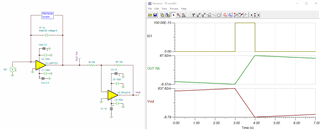Other Parts Discussed in Thread: TINA-TI, OPA210, OPA928, OPA928EVM
Hello,
I am not an electrical engineer but a chemical one. Therefore, my question is probably foolish/basic.
I would like to build a circuit that is able to measure the fC charge that is induced by a single particle flying through a Faraday cage. The particle will stay in the faraday cage for approximately 0.1 to 1 second.
On the internet, I found that I should use a transimpedance configuration of an op-amp, use a Faraday cage (grounded thin aluminum foil), and I should put condensers close to the power supply pins of the op-amps.
My idea was to use one LMP7721 as inverting charge amplifier and the second one as inverting voltage amplifier. And the Third one is a voltage follower of the output of the first amplifier so I can get larger gains on the second amplifier, The output of the voltage follower is filtered from the signal and passes only the offset voltage (caused by the bias current?). This works in TINA-TI, but not in reality. The output does not desaturate. Can you guide me on what I did wrong or if I should use a completely different circuit to achieve what I want?
Below is my TINA-TI model. The VG1 and C1 should simulate the induction caused by the charged particle flying through the faraday cage. Next, I attached a transient simulation; the idea is that I will let the circuit stabilize. After the stabilization, I can inject the charge of 100fC (increase the VG1 voltage), and this will translate to a 100mV response on the output, which I can measure. The last image is a gain which is constant for my frequency.
I am able to make this circuit work for a resolution of 10pC when I remove the voltage follower and connect the non-inverting input of the U2 to the ground and tune down the gain on the U2. But I need those 2 orders of magnitude to achieve the required accuracy.
Since it is important for me to know how much charge was on the particle during the entrance and exit from the faraday cage, and the problem with the first amplification stage is that I need to use a large capacitor (C2) to keep the stability, which lowers the gain. Would it be possible to somehow sample the charge only during the entrance and exit? This would shift the bandwidth to higher frequencies which would allow a decrease in the value of C2, thus increasing the gain by those few magnitudes that I need.
I would upload the TINA file if I knew how.





